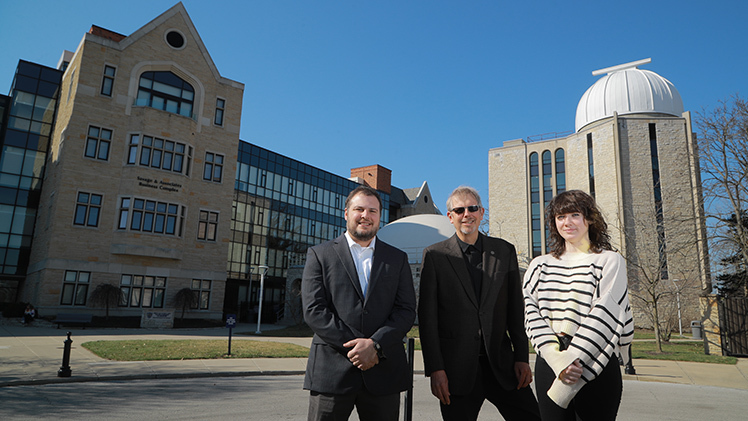Two University of Toledo faculty members and one graduate student will lead research projects on the third and so far most competitive cycle of scheduled observation time on the James Webb Space Telescope.
Dr. Tom Megeath, Distinguished University Professor of astronomy, is principal investigator on a proposal looking at protostars.

From left, Dr. Eli Visbal, assistant professor of astronomy, Dr. Tom Megeath, Distinguished Professor of Astronomy, and Mandy Caputo, a doctoral student studying astrophysics, will lead the research projects.
Mandy Caputo, a doctoral student studying astrophysics with Dr. Rupali Chandar, her advisor and professor and associate chair of the Department of Physics and Astronomy, will lead a project to observe a nearby extreme star-forming galaxy called NGC 1614.
Dr. Eli Visbal, an assistant professor in the Department of Physics and Astronomy, submitted a successful theory proposal not to observe a new target using the telescope but to explore ways to use its data to address challenges for an emerging observational technique called intensity mapping.
Megeath was allocated nearly 175 hours on the James Webb, accounting for the third largest project in this cycle and the largest ever project on the formation of stars in our galaxy.
He and his co-principal investigator, Dr. Yao-Lun Yang of the Japanese research institute RIKEN, along with collaborators in Chile, Germany, India, Italy, Poland, the Netherlands, Saudi Arabia, South Korea, Spain, Taiwan, the United Kingdom and the United States, plan to point the telescope toward a cloud of gas and dust that’s located within the constellation Orion. It’s filled with protostars that are launching jets of gas as they rapidly pull in the gas and grow in size.
The James Webb’s infrared observations will allow researchers to see through the dust surrounding these protostars at a resolution impossible with any other astronomical facility.
The researchers will explore how protostars inject energy into their surroundings, a process they believe may be important in determining the masses of stars in our galaxy. They’ll also explore the composition of the ice that coats the small grains of dust surrounding protostars, which they believe may hold valuable insights into the early chemistry of planet formation.
“These ices may be important in establishing the conditions that support life on planets,” Megeath said. “This is a very exciting project that should significantly advance our understanding of the star formation and related processes in a galaxy like our Milky Way.”
Caputo will explore a different aspect of star formation with her roughly four-and-a-half hours on the James Webb. She proposes to look toward a nearby extreme star-forming galaxy, using the unprecedented infrared capabilities of the space telescope to cut through the dust that has until now hidden the star clusters inside. Clusters are groups of tens of thousands to millions of stars.
“There have been other infrared space telescopes, but they don’t have anywhere near the resolution of the James Webb. We wouldn’t have dreamed of seeing these clusters with them,” Caputo said.
Caputo will look at her new data alongside data from the Hubble Space Telescope to better understand the physical processes responsible for the formation of stars and clusters in one of the most intense star-forming environments that astronomers can study. She also expects her work to help astronomers better interpret their observations of young, distant, extreme star-forming galaxies.
Only 12% of accepted proposals are led by students, according to the Space Telescope Science Institute. Caputo, who has previously worked with data gathered through Chandar’s second-cycle research project exploring cluster formation on the Webb, credited the mentorship of her advisor.
“Rupali is very knowledgeable about what makes a strong proposal and at presenting concepts in a way that are accessible to people who aren’t as invested in our niche corner of astrophysics,” Caputo said. “It still feels surreal to have had my proposal selected. It’s exciting.”
As a theoretical astrophysicist, Visbal will pursue a project that looks a bit different. He submitted a successful theory proposal, which means he was not allocated observing hours on the telescope. Instead, he will receive resources and support to explore ways astronomers can use James Webb data to improve intensity maps that probe the large-scale structure of the universe across hundreds of millions of lightyears.
Intensity maps are 3D maps created with spectral line emission from galaxies or the gas in between them. Because they are relatively low resolution, they are less useful for insights into specific astronomical objects or regions than they are for broader explorations. Visbal, for example, is interested in using intensity maps to explore the early universe including the so-called epoch of cosmic reionization when gas between galaxies transitioned from neutral to ionized.
Visbal will explore ways to improve intensity maps by cross-correlating them with direct observations of galaxies from the James Webb. He expects this method to address a challenge of intensity maps that are often contaminated with spurious and thus misleading data.
“These intensity maps are thought by some to be one of the most promising ways to understand the early universe. We’ll see equipment coming online in the coming decades to facilitate them, like the SphereX Observatory and Hydrogen Epoch of Reionisation Array (HERA),” Visbal said. “We think that we can make intensity maps much more valuable by combining them with Webb data, which should remove the contaminants and verify the signal.”
More than 6,000 investigators submitted proposals in what has been the most competitive cycle to date on the James Webb, according to the Space Telescope Science Institute, which announced the latest round successful proposals in late February. There are 253 observational, 25 archival and 12 theory proposals that made the cut.
UToledo astronomers have led at least one research project on each cycle of scheduled observing time since the infrared space telescope was launched into space in December 2021.